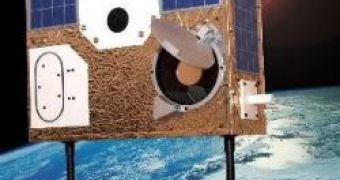Many people don't know this but there are about 5,000 Near Earth Objects at least 10 kilometers wide that may one day decide to come crashing down on the surface without us even knowing. The consequences of an impact with such a large object are now known, but considering that an object that size may have been responsible for the extinction of the dinosaurs, I think it's fair to say it's not going to be good.
Most of these objects are being tracked with the help of Near Earth Object programs using ground based telescopes. This poses somewhat of a problem because while most of these objects have highly elongated orbits taking them way beyond that of Earth, some are restricted to the inner regions of the solar system which makes them incredibly hard to spot, especially considering that they must be observed when the Sun is just below the horizon. The powerful glow of the Sun can easily hide these objects.
The Near Earth Object Surveillance Satellite, or NEOSSat for short, currently being developed by the Canadian Space Agency, will be able to observe objects within the orbit of the Earth, although when it will be finished it won't be larger than a suitcase and will weigh only 60 kilograms. NEOSSat is expected to launch into space next year and will only cost 10 million US dollars to build and launch. Its primary observation tool is a 15-centimeter telescope mirror, smaller than most of the telescopes used by amateur astronomers.
NEOSSat should be able to catalogue at least 50 percent of the NEOs 1 kilometer across. Because these objects are most likely to be found in the vicinity of the Earth, they are the ones to pose a grave danger. Timothy Spahr, astronomer at the Harvard-Smithsonia Center for Astrophysics believes that the camera technology advancements in ground based telescopes should allow them to stop close-in objects, but he cannot say how much of an improvement the NEOSSat will bring.
"If nothing else, they're going to show people what you can do from Earth's orbit. And it's not breaking the bank. Even a modest-sized telescope will outperform anything you can put on the ground", he said.
Alan Harris on the other hand is even more pessimistic. The Space Science Institute researcher believes that the NEOSSat cannot bring any improvement to ground-based NEO surveys and spotting near Earth objects coming in the close proximity of the planet is in fact not that hard with ground-based telescopes. Additionally, the mission would be of higher interest if it were to study the asteroids orbiting close to the Sun, even though they do not pose much of a danger to Earth.
"As a scientist, I have a keen interest in exploring the entire solar system, and indeed the far inner regions, inside of Venus and even Mercury. NEOSSat may indeed contribute to our knowledge of extremely interior asteroids, and in that light I look forward to what it may find", said Harris.

 14 DAY TRIAL //
14 DAY TRIAL //